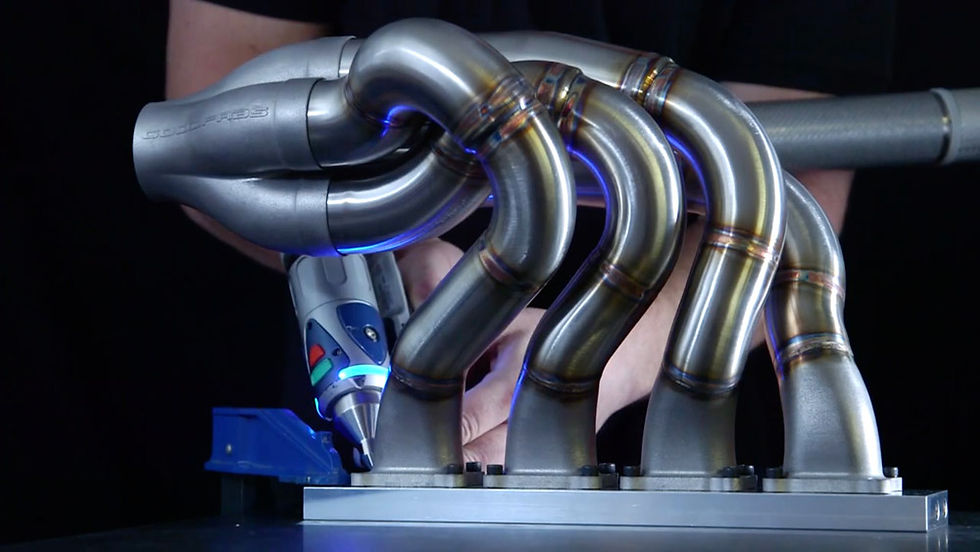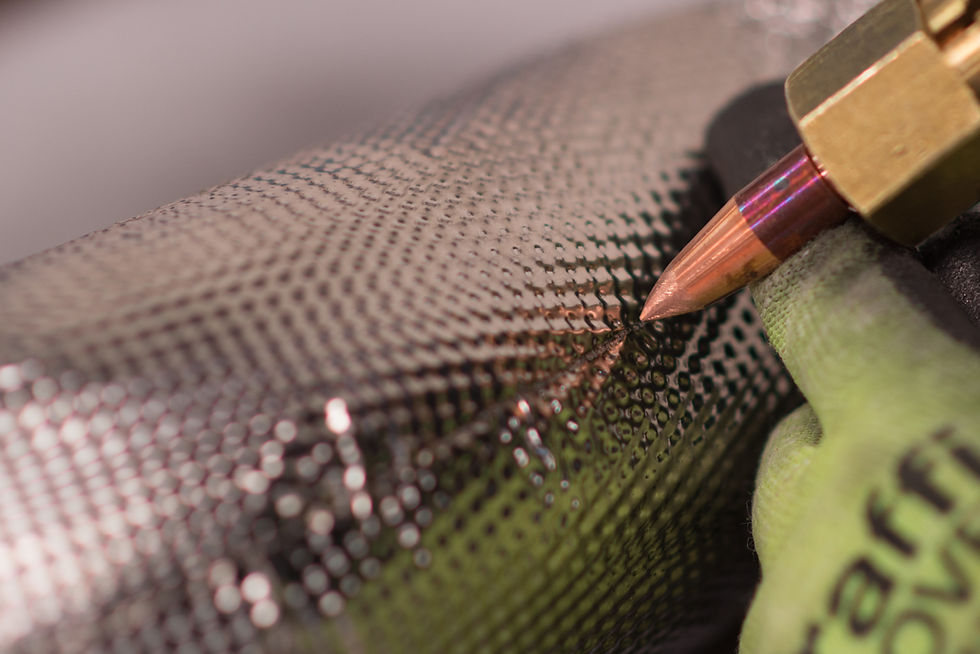Welding and Metallurgical terms finally explained.
- Didier De Lille
- Aug 24, 2017
- 7 min read

The terms used in metallurgy can be very complex. Welding terms are usually very specific and a lot of the terms are also misunderstood, below you can find some of the most common used ones and what they actually mean.
Abrasive: Slag used for cleaning or surface roughening.
Active Flux: Submerged-arc welding flux from which the amount of elements deposited in the weld metal is dependent upon welding conditions, primarily arc voltage.
Adhesive Bonding: Surfaces, solidifies to produce an adhesive bond.
Air Carbon Arc Cutting: An arc cutting process in which metals to be cut are melted by the heat of carbon arc and the molten metal is removed by a blast of air.
Age hardening: Hardening by aging the material, for example: A material can become harder but more brittle over time.
Aging: A change of material properties that happens at ambient (or close to) temperatures after hot working, heat treating quenching or cold working.
Alloy: A metal composed of two or more chemical elements of which at least one is a metal.
Alloy steel: Steel containing a significant quantity of alloying elements (other than carbon and small amounts of manganese, silicon, sulphur and phosphorus added to produce changes in mechanical or physical properties.
Annealing: Heating metal to a suitable temperature followed by cooling to produce discrete changes in microstructure and properties.
Arc Blow: The deflection of an electric arc from its normal path because of magnetic forces.
Arc Cutting: A group of thermal cutting processes that severs or removes metal by melting with the heat of an arc between an electrode and the work piece.
Arc Force: The axial force developed by an arc plasma.
Arc Gouging: An arc cutting procedure used to form a bevel or groove.
Arc Length: The distance from the tip of the electrode or wire to the work piece.
Arc Time: The time during which an arc is maintained.
Arc Voltage: The voltage across the welding arc.
Arc Welding: A group of welding processes which produces coalescence of metals by heating them with an arc, with or without the application of pressure and with or without the use of filler metal.
Arc Welding Deposition Efficiency (%): The ratio of the weight of filler metal deposited to the weight of filler metal melted.
Arc Welding Electrode: A part of the welding system through which current is conducted that ends at the arc.
Austenite: A solid solution of one or more alloying elements in the fcc structure of iron.
Beach marks: Crack arrest ‘lines’ seen on fatigue fracture surfaces.
Billet: A solid piece of steel that has been hot worked by forging, rolling or extrusion, often used for machining.
Braze Welding: A method of welding by using a filler metal, having a liquidus above 840 °F (450 °C) and below the solidus of the base metals.
Brittle fracture: Fracture precedes by little or no plastic deformation.
Brittleness: The tendency of a material to fracture without first undergoing significant plastic deformation.
Butt Joint: A joint between two members lying in the same plane.
Carbide: a compound of carbon with metallic elements (f.d. tungsten, chromium).
Carbon equivalent (CE): A ‘weldability’ value that takes into account the effect of carbon and other alloying elements on a particular characteristic of steel.
Carbon steel: A steel containing only small quantities of elements other than carbon.
Cast iron: Iron containing more than 2 percent carbon.
Cast steel: Steel castings ,containing less than 2 percent carbon.
Cleavage: Fracture of a crystal by crack propagation.
Constitutional diagram: A graph showing the temperature and composition of limits of various phases in a metallic alloy.
Crack initiator: Physical fracture which encourages a crack to start.
Creep: Time dependent strain occurring under stress.
Critical cooling rate: The maximum rate at which austenite needs to be cooled to ensure that a particular type of structure is formed.
Crystalline: The general structure of many metals.
Crystalline fracture: A fracture of a metal showing a grainy appearance.
Decarburization: Loss of carbon from the surface of a ferrous alloy caused by heating.
Deformation: General term for strain or elongation of a metal’s lattice structure.
Deoxidation: Removal of oxygen from molten metals by use of chemical additives.
Diffusion: Movement of molecules through a solid solution.
Dislocation: A linear defect in the structure of a crystal.
Ductility: The capacity of a material to deform plastically without fracturing.
Elastic limit: The maximum stress to which a material may be subjected without any permanent strain occurring.
Etching: Subjecting the surface of a metal to an acid to reveal the microstructure.
Fatigue: A cycle or fluctuating stress conditions leading to a fracture.
Ferrite: A solid solution of alloying elements in bcc iron.
Fibrous fracture: A fracture whose surface is characterized by a dull or silky appearance.
Filler Material: The material to be added in making a welded, brazed, or soldered joint.
Fillet Weld: A weld of approximately triangular cross section that joins two surfaces approximately at right angles to each other in a lap joint, T-joint, or corner joint.
Filter Plate: A transparent plate tinted in varying darkness for use in goggles, helmets and hand shields to protect workers from harmful ultraviolet, infrared and visible radiation.
Flame Spraying: A thermal spraying process using an oxy-fuel gas flame as the source of heat for melting the coating material.
Flammable Range: The range over which a gas at normal temperature (NTP) forms a flammable mixture with air.
Flat Welding Position: A welding position where the weld axis is approximately horizontal and the weld face lies in an approximately horizontal plane.
Friction Stir Welding: A solid-state welding process, which produces coalescence of material by the heat obtained from a mechanically induced rotating motion between tightly butted surfaces. The work parts are held together under pressure.
Grain: An individual crystal in a metal or alloy.
Grain growth: Increase in the size of the grains in metal caused by heating at high temperature.
Grain orientation: The direction in which the grains of the material are pointing.
Hardenability: The property that determines the depth and distribution of harness induced by quenching.
Harness: Resistance of a metal to plastic deformation by indentation. This can be measures by Brinel, Vickers or Rockwell testing.
Hot Crack: A crack formed at temperatures near the completion of weld solidification.
Inclusion: A metallic or non-metallic material in the matrix structure of a metal.
Initiation point: The point at which a crack starts.
Joint: The junction of members or the edges of members that are to be joined or have been joined.
Lamellar tear: A system of cracks or discontinuities, normally this is seen in a weld.
Laser Beam Cutting: A process that severs material with the heat from a concentrated coherent beam impinging upon the work-piece.
Laser Beam Welding: A process that fuses material with the heat from a concentrated coherent beam impinging upon the members to be joined.
Leg of Fillet Weld: The distance from the root of the joint to the toe of the fillet weld.
Lattice: A pattern (physical arrangement) or a metal’s molecular structure.
Melting Range: The temperature range between solidus and liquidus.
Micro cracks: Small ‘brittle’ cracks, normally perpendicular to the main tensile axis.
Normalizing: Heating a ferrous alloy and then cooling in still air.
Notch brittleness: A measure of the susceptibility of a material to brittle fracture at locations of stress concentration.
Nitriding: Surface hardening process using nitrogenous material.
Plasma Arc Cutting (PAC): An arc cutting process using a constricted arc to remove the molten metal with a high-velocity jet of ionized gas from the constricting orifice.
Plasma Arc Welding (PAW): An arc welding process that uses a constricted arc between a non-consumable electrode and the weld pool (transferred arc) or between the electrode and the constricting nozzle (non-transferred arc). Shielding is obtained from the ionized gas issuing from the torch.
Plastic deformation: Deformation that remains after release of the stress that caused it.
Precipitation hardening: Hardening by managing the structure of a material, to prevent the movement of dislocations.
Quench hardening: Hardening by heating and then quenching quickly, causing austenite to be transformed into martensite.
Recovery: Softening of cold-worked metals when heated.
Segregation: Non-uniform distribution of alloying elements, impurities or phases in a material.
Soaking: Keeping metal at a predetermined temperature during heat treatment.
Solid solution: A solid crystalline phase containing two or more chemical species.
Solution heat treatment: Heat treatment in which an alloy is heated so that its constituents enter solid solution and then cooled rapidly enough to ‘freeze’ the constituents in solution.
Strain aging: Aging induced by cold working.
Strain hardening: An increase in hardness and strength caused by plastic deformation at temperatures below the recrystallization range.
Stress-corrosion cracking: Failure by cracking under the combined action of corrosion and stress.
Tempering: Supplementary heat treatment to reduce excessive hardness
Temper brittleness: An increase in the ductile-brittle transition temperature in steels.
Tensile Strength: The maximum stress a material subjected to a stretching load can withstand without tearing.
Thermal Conductivity: The quantity of heat passing through a material.
Thermal Spraying: A group of processes in which finely divided metallic or non-metallic materials are deposited in a molten or semi molten condition to form a coating.
Thermal Stresses: Stresses in metal resulting from non-uniform temperature distributions.
Thermionic: The emission of electrons as a result of heat.
TIG Welding: See Gas Tungsten Arc Welding (GTAW).
Toughness: Capacity of a metal to absorb energy and deform plastically before fracturing.
Transformation temperature: The temperature at which a metal starts to exhibit brittle behaviour.
Weldability: The capacity of a material to be welded under the fabrication conditions imposed into a specific, suitably designed structure and to perform satisfactorily in the intended service.
Weld Bead: The metal deposited in the joint by the process and filler wire used.
Welding Leads: The work piece lead and electrode lead of an arc welding circuit.
Welding Wire: A form of welding filler metal, normally packaged as coils or spools, that may or may not conduct electrical current depending upon the welding process used.
Weld Metal: The portion of a fusion weld that has been completely melted during welding.
Weld Pass: A single progression of welding along a joint. The result of a pass is a weld bead or layer.
Weld Pool: The localized volume of molten metal in a weld prior to its solidification as weld metal.
Weld Puddle: A non-standard term for weld pool.
Work hardening: Hardening of a material due to straining or cold working.









Comments